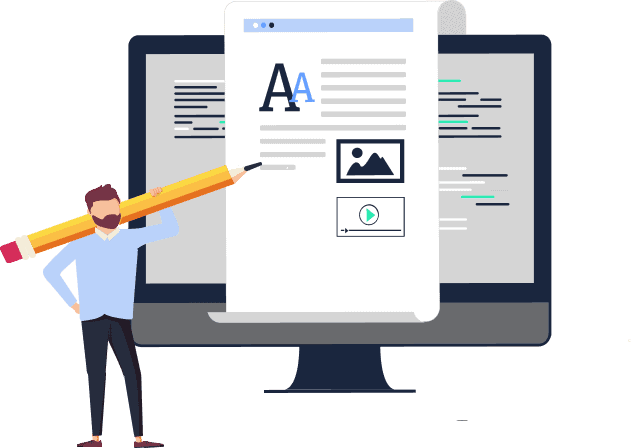

Our field evolved a ton in 2021! We’ve pulled together the most popular resources for you to enjoy and keep handy in the year ahead. We know you might be thinking, “Another roundup?” Yes, but you’ll want to bookmark this one. Let’s get to it.
1. How to write digital products with personality. It’s possible to add character to your product in many ways—with colors, fonts, illustrations, and more. Nick DiLallo highlights how choosing the right words at the right time will shape the entire user experience.
2. Tackling complex design debt. Inconsistent product functionality, wildly differing UI components, and conflicting terminology can have significant consequences for your business—if left unchecked. Alex Potrivaev, Senior Product Designer at Intercom, shares a simple three-step framework for managing it.
3. How Atlassian’s design teams go from idea to execution. Natalie Coy took to Invision’s blog to offer a behind-the-scenes look at Atlassian’s design process. And the team was gracious enough to share their top Confluence templates to help teams like yours. Check it out.
4. How not being a native English speaker makes me a better UX writer. Companies often list “native English speaker” as a job requirement but are they missing out on first-class writing talent? We think so. This blog post by Dragana Milovanovic is an important reminder of why not being a native English speaker makes you perfect for user experience writing roles. And key to that is pure human empathy.
5. Jargon and its discontents. Good ol’ jargon. We love to hate it, but sometimes we can’t write without it. Lynne Carstarphen, Senior Writer at Square, offers a glimpse into crafting clear, transparent financial copy and how to discern if and when jargon is appropriate.
6. “Learn more” is not enough. Are your CTAs serving a specific purpose, or are they acting more like fillers? Alice Chen makes the case for why descriptive CTAs are more accessible, SEO-friendly, and contribute to an overall better UX. Read this post on our blog.
7. How to structure and present your UX portfolio. The infamous interview portfolio presentation. If just thinking about this gives you anxiety, just know you’re not alone. It all boils down to showing that you can articulate your ideas, processes, and concepts. Need inspiration? UXfolio has your back.
8. Content rookie: UX writing, content strategy, and content design. Where is the industry now? Where is it going? And why are the roles and titles so freaking confusing? In this podcast episode, Jane Ruffino and Nicole Michaelis discuss all things UX writing. Give it a listen.
9. Career reflection and advice with Michael J. Metts. This very, very thorough post over on WorkingInContent.com covers UX, content, conversational AI, and Michael’s career to date. He also shares advice for those navigating content careers. A fabulous resource to keep handy.
10. 10 tools for UX writers and content designers. Fire up your browser. Get your bookmarks ready. Here are some popular tools to understand your audience and craft content that addresses their needs. Kudos to Christopher Greer for this list.
11. The UX on this small child is terrible. Quite possibly the most relatable post yet? Read on to see Leslie Ylinen’s proposed feedback for creating a more compatible user-centered child experience. More from McSweeney’s.
12. How to “steal like a designer” and boost creativity. Great ideas aren’t born out of thin air… they’re stolen. It’s not your fault—it’s science! It turns out humans can’t ideate without prior sensory input. This great read from Daria Vorontsova, Product Designer at Intercom, shows how you can tap into “stealing” to produce your next designs with ease.
13. Design communication is a critical skill. Good designing = good communicating. Kazden Cattapan, Product Designer at Shopify, highlights how you can build trust by explaining your designs effectively and understanding the needs of your stakeholders. Great frameworks to follow, folks.
14. Testing copy at Netflix. The problem: The Netflix team lacked an efficient way to run copy tests, including language-focused optimizations, at scale. The solution? Enter Shakespeare. Find out how the team deployed a tool that lets content designers run lighter-weight copy tests without heavy engineering support. More from the Netflix Technology Blog.
15. A proven method for showing the value of good UX. Looking to get leadership buy-in? Start by identifying frustrations caused by poor UX and isolating said frustration costs. Thanks to Jared Spool for this one.
16. The design process ≠ a process. Fact: one approach does not fit all scenarios. Instead of just thinking of design as a procedure to follow, think of it as a toolbox. Then, you’ll learn to reach for the right tools in the right situations. Jordan Bowman dropping knowledge over on UX Tools.
17. How would a dog write error messages? How would a bird use punctuation? Jane Ruffino is at it again with this tabletop exercise to help develop your product’s voice, tone, and style. Check out the Miro file and get to writing.
18. Experience consistency is key. And the key to consistent experiences is asset mapping. This article from Nielsen Norman Group breaks down how to use asset maps vs. customer-journey maps, plus the benefits of doing so in the first place. Let’s see those maps!
19. So you’re writing a writing guide. Now what? Whether you’re a new writer or just new at a company, acclimating to the brand’s voice takes time. Justin Whaley gives us a glimpse at the new source for Square’s voice and tone.
20. Understanding visual hierarchy. Do your users follow a Z of F scanning pattern while browsing your site? How can you design your content to naturally fit their searching behaviors? Thanks to Interaction Design Foundation for outlining how visual hierarchy helps keep our content organized and aligned with natural eye patterns.
21. Make more mistakes! Cayla Dorsey is a content designer at Microsoft, and she made a bunch of errors in her first year. In her article, she describes these learning experiences, but also why she hopes you make the same mistakes too.
22. Why should content come first? We really appreciate this web designer’s view of what makes content so important to design—and why it should come first. Forward this to anyone who doubts investing in content from the start.
23. How to make your documentation inclusive. Google developers are getting inclusive, and we love it! See what Google’s documentation style guide currently recommends for tech writers to avoid potentially harmful phrases and terms. A fantastic resource to share with your dev team.
24. Computers are getting better at writing. What do GPT-3 and Kafka have in common? This New Yorker piece explores how artificial intelligence and machine learning will transform our education system, the fields we work in, and the future of creative writing. A fascinating—and only mildly terrifying—look at AI tools like Sudowrite.
25. Don’t fear Figma. Are you feeling frustrated with Figma? Looking for pointers on how to get the most out of the tool? This resource, curated by Mateus Da Silva, Product Designer at Netflix, is a fantastic place to start. It includes everything from beginner pointers to full-length courses. Have some fun with it!
26. Content is complex. Content has never been more important, but the truth is it’s freaking hard. In this blog post for Gather Content, co-founder and product director Angus Edwardson outlines three effective components of ContentOps to level up the way we all work with, uh, content.
27. 6 must-try workshops for content designers. This post from Rachel McConnell outlines everything from the pre-mortem to stakeholder mapping and the best way to approach workshops for your organization’s content needs. Before you schedule your next session, definitely give this a read!
28. Jump on this UX research tool train. The team over at User Interviews polished up the “UX Research Tools subway system,” and it appears to be running smoother than ever. Yes, it’s intended to be read like a real public transit map. There are even 18 subway lines, each representing a function key to the user research workflow. Hop aboard and save this for future design commutes!
29. Inclusive writing at Apple. At the latest WWDC conference, we got a sneak peek at all the new exciting updates across our favorite apps, devices, and browsers. It also looks like the Apple content team is taking a fresh look at their own internal style guide—releasing an updated section dedicated specifically to inclusive writing. We love to see it.
30. 11 key content design considerations. Content design is complex! In this blog post, Erica Jorgensen, Senior UX Content Designer at Microsoft, shares the key things she thinks about and takes into consideration while doing the work. Next time someone asks you to “whip up” some content real quick, just send them the link to this article…
31. Four emerging roles in content. We can debate job titles all day long, but we’re at the point where we can all recognize universal content roles within organizations. Right? In this LinkedIn post, John Collins of Atlassian untangles four content functions: content strategy, content design, content engineering, and content ops. Thoughts? Can you poke holes in this theory?
32. Accessibility shouldn’t be an afterthought. We appreciate the work Craig Abbott and his team are doing over at DWP Digital to create a community-led accessibility manual that doesn’t leave anyone out of the conversation. Read more on GOV.UK.
33. How do you design content for death? When you work in funeral care, you must operate with a high level of compassion, clarity, and empathy—all things super relevant to UX writing work. Helen Lawson and the content design team at Co-op Funeralcare share how they embody four fundamental principles in their content design and communication decisions.
34. All about ContentOps audits. Way less scary than a tax audit, we promise. In this post from Llibertat, Rob Mills outlines what they are, how to do them, and why they’re super important for understanding your org. Audit away!
35. Who doesn’t love free design tools? Yes, you’re free to use these 33 online design tools the next time you’re in a design pickle. There are some really fun font options, infographic templates, photo resources, and customizable videos. Thanks to HubSpot for this handy roundup.
36. Establishing a UX writing practice at OutSystems. Companies restructure, responsibilities change, and new hires come on board. You know the drill! During one of these moments of change, the folks at OutSystems realized it was time to make space for a UX practice. Here’s a great behind-the-scenes look from Marina Calado at what it really takes to build from the ground up.
37. All for one, and one for all. The folks over at Adobe released their new inclusivity guidelines for UX writing as part of the Spectrum design system. This guide breaks down writing about people, writing for readability, and writing with visuals. Give the inclusive language guidelines a read!
38. 36% is the magic number. Jonathon Colman, Former Senior Design Manager at Intercom, set out to uncover how much text takes up screen real estate in the most popular iOS apps. This case study does not disappoint.
39. The UX writer’s checklist. Pre-design planning? Check. Aligning with designers? Check. The folks at Frontitude spoke with 100+ teams about where content design fits within their overall processes. Check out these six steps for an efficient UX writing workflow that puts content at the forefront.
40. The price is write. The way prices are designed on product pages is more nuanced than you might think. So how can we balance UX writing ethics with marketing priorities? Blanca Rego, a content designer and localization specialist based in Spain, shares some very useful insights on our blog.
41. Houston, we have a content definition problem. If you don’t debate your title with colleagues, do you even work in content design? UX writing? Content strategy? What are we calling ourselves these days? Roles and responsibilities aside, Kristina Halvorson’s blog post gives us the rallying cry to align moving forward.
42. Let’s make content design official. In case you missed it, Lyft is following in several big tech footsteps (think Facebook, Uber, Firefox, and Shopify) to change their team titles from UX Writing to Content Design. Amy Lipner shares how a discipline-wide struggle to find the “right title” mirrors our day-to-day work finding “the right word.” Read on to see what this means for their team and the discipline going forward.
43. So long, portfolio perfectionism. What do hiring managers look for in portfolios? Jonathon Colman answers this million-dollar question in this post from HubSpot. Perhaps the most important reminder of all: There’s no such thing as perfect. Read that again. Progress wins over perfection every. single. time. Get your hands on this advice.
44. Up for a new challenge? Looking for a low-key way to brush up on your convo design skills? Enter the Daily Conversation Design Challenge in collaboration with UXCC course author Hillary Black and the one and only Ryan Farrell. Sign up to get 14 days of free practice! You can add your prompts to your portfolio, share ’em with the LinkedIn group for feedback.
45. What makes an experience memorable? Delighting the user with clever microcopy has become the norm. To stand out, brands need to find ways to engage on a deeper level. Enter the memorable experience framework! This is a super long read from Audree Lapierre, but it’s worth every second. Grab a coffee (or tea, if that’s your thing) and get ready to take notes.
46. The ultimate list of games for bored (or curious) designers. Did we just accidentally spend ten minutes playing Can’t Unsee instead of writing this newsletter? Maybe. Next time you need a creative break, jump into one of these games.
47. Show me the money! Companies often say the salary on offer is “competitive,” but how do we really know that? When we’re negotiating our salary for a new job or a raise at our current company, how can we tell what’s a fair deal? Wonder no more. In the name of salary transparency and pay equity, here’s a repository of design salaries, including for UX writers and content designers.
48. Inclusive guidelines from Shopify. At Button 2021, Shopify announced accessible and inclusive language updates made to the Polaris design system—including examples for anti-racist and ungendered content. Give the new guidelines a read and forward ’em on to your team.
49. You get a link! You get a link! Seriously, this compendium of articles, links, tools, and other resources shared by speakers at Online Together: Fall Summit 2021 is TOO GOOD. Just when you think you’re done scrolling, it keeps on going. Many thanks to An Event Apart for compiling.
50. How to write error messages without errors. What’s the essence of an error message? What’s the anatomy of an error message? If these questions sound all deep and philosophical, it’s because error messages deserve as much thought as we can give them. They can make or break the user’s experience with our products. Andy Welfle, UX content strategy manager at Adobe, was happy he and his colleagues finally got guidelines on writing error messages published in their design system.

Explore our content design and UX writing training:
Get our weekly Dash newsletter packed with links, regular updates with resources, discounts, and more.
